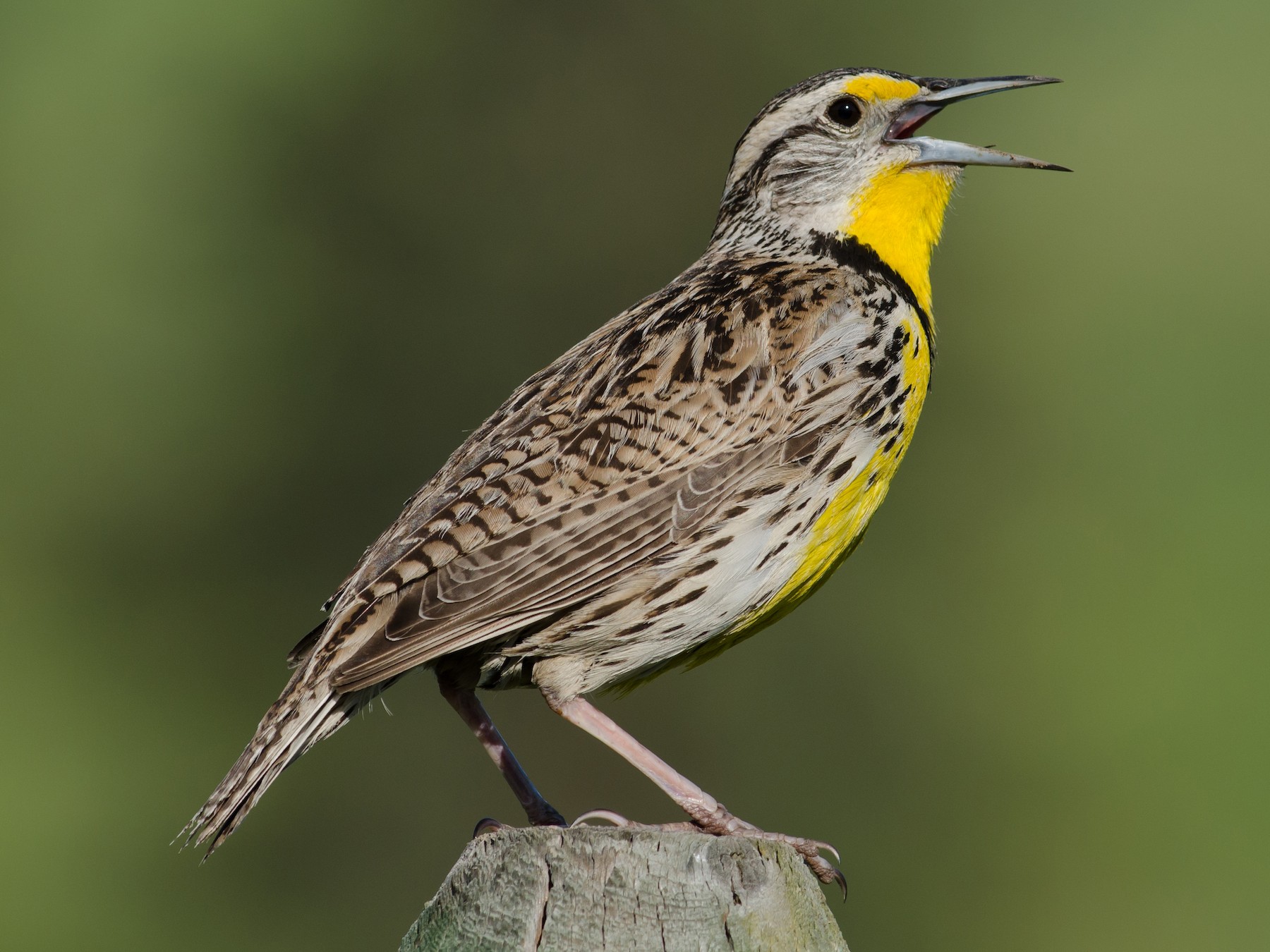In Montana, yellow birds are a common sight during the arrival of warblers in spring and summer. However, in winter, only a few species of yellow birds remain.
To aid you in identifying the yellow birds you spot in Montana, this comprehensive guide offers pictures, identification information, song recordings, and migration patterns.
Most yellow birds in Montana belong to the warbler, oriole, or tanager families, and sometimes the females exhibit distinct appearances compared to the males of their species.
With the abundance of information provided in this guide, identifying yellow birds becomes much easier. The following list presents the yellow birds most frequently observed in Montana during spring and summer (May and June), based on ebird checklists:
Yellow birds in Montana during summer: Western Meadowlark, American Goldfinch, Yellow Warbler, Yellow-rumped Warbler, Cedar Waxwing, Evening Grosbeak, Western Tanager, Yellow-headed Blackbird, Common Yellowthroat, Western Kingbird, Orange-crowned Warbler, Wilson’s Warbler, American Redstart, Nashville Warbler, Baltimore Oriole, Orchard Oriole, Dickcissel.
Yellow birds in Montana during winter: Lesser Goldfinch.
Yellow birds in Montana during migration: Magnolia Warbler, Palm Warbler, Cape May Warbler, Canada Warbler, Scarlet Tanager.
Continue reading to discover how to identify the yellow birds you have encountered.
Here are 23 yellow birds found in Montana:
1. Western Meadowlark
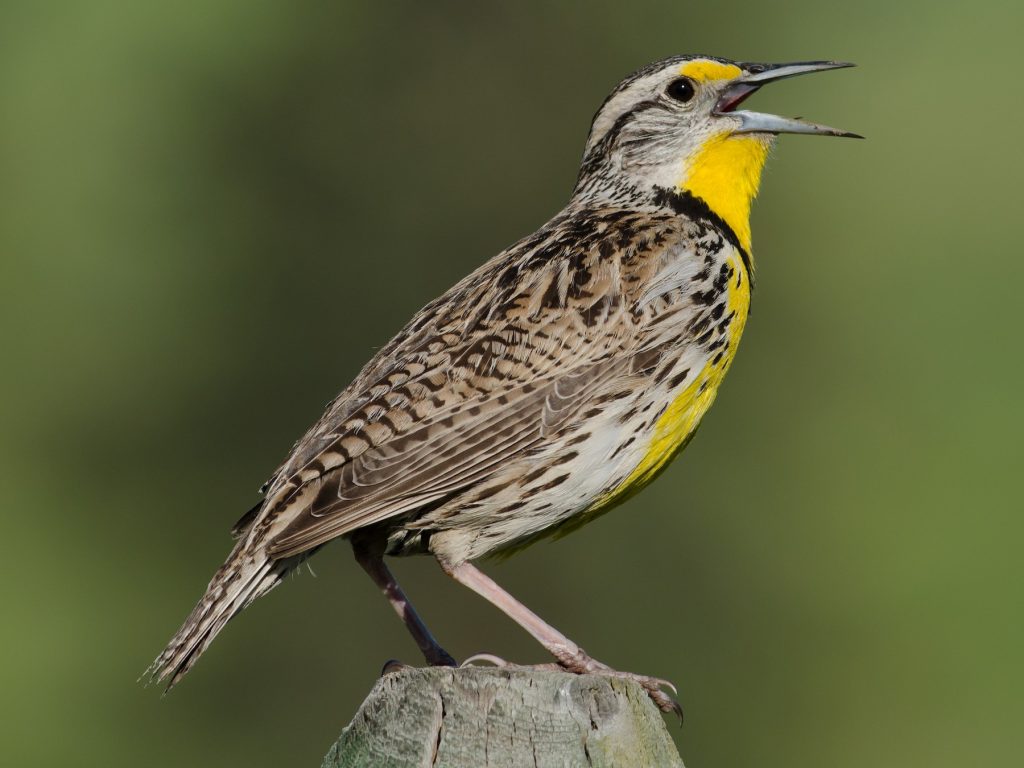
During the breeding season, Western Meadowlarks frequently grace Montana’s landscapes. They feature in approximately 27% of summer checklists submitted by birdwatchers in the state.
With their vibrant yellow bellies and melodious songs, Western Meadowlarks have the power to brighten your day.
Belonging to the blackbird family, they possess brown and white upperparts, with a black V-shaped band adorning their bright yellow chests, which turns gray in winter.
Scientific name: Sturnella neglecta
Length: 6.3-10.2 inches (16-26 cm)
Weight: 3.1-4.1 ounces (89-115 g)
Wingspan: 16.1 inches (41 cm)
While some Western Meadowlarks migrate from northern US states and Canada to southern states for winter, those in the west and midwest remain in Montana throughout the year.
You can often find Western Meadowlarks foraging alone or in small flocks on the ground in grasslands, meadows, and fields. They tend to avoid wooded areas or dense shrubs.
Their diet primarily consists of insects during summer and shifts to seeds and grains during winter.
If you wish to hear the pleasant series of tweets, warbles, and whistles produced by Western Meadowlarks, check out the provided sound recording.
Nests of Western Meadowlarks are constructed in depressions on the ground in grasslands. These nests are filled with soft materials such as grass and may feature a roof made of grass and plant stalks.
To attract Western Meadowlarks to your backyard, offer sunflower seeds and cracked corn.
Fun fact: Western Meadowlarks have been designated as the state bird in six US states.
2. American Goldfinch
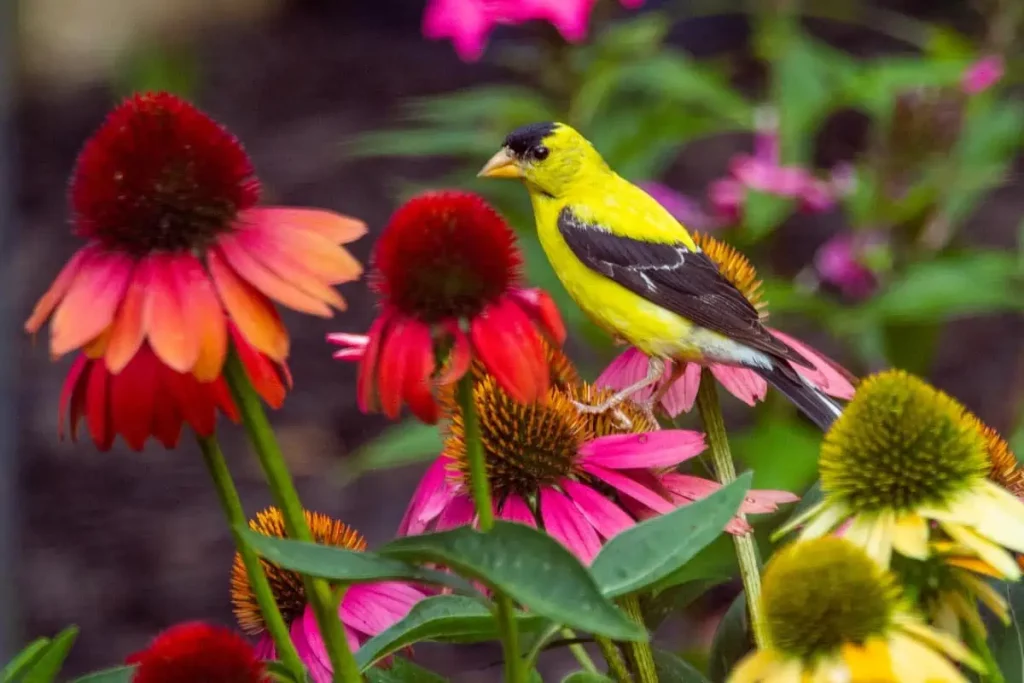
While American Goldfinches spend the breeding season in Montana, some individuals remain in the southern part of the state year-round. They are recorded in 16% of summer checklists and 7% of winter checklists in Montana.
These birds are particularly beloved due to the vibrant yellow and black coloring exhibited by males during spring. In contrast, females and winter males appear duller in brown.
Scientific name: Spinus tristis
Length: 4.3-5.1 inches (11-13 cm)
Weight
: 0.4-0.7 ounces (11-20 g)
Wingspan: 7.5-8.7 inches (19-22 cm)
American Goldfinches can be found across most of North America and are typically resident year-round. However, those that breed in Canada and the Midwest migrate to southern US states for winter.
You can spot American Goldfinches foraging in weedy fields, overgrown areas, suburbs, parks, and backyards. Their diet primarily consists of sunflower, thistle, and aster plants.
The provided sound recording allows you to listen to the delightful song of the American Goldfinch.
Nests of American Goldfinches are commonly found in shrubs and are constructed from interwoven rootlets and plant material, secured with spider webs. The nest contains up to seven eggs, which take around two weeks to hatch. The young remain in the nest for approximately two to two and a half weeks.
To attract American Goldfinches to your backyard, plant thistles and milkweed, and provide bird feeders with sunflower seeds and nyjer seed.
Fun fact: American Goldfinches have no interest in raising cowbird chicks, as their strictly vegetarian diet is unsuitable for the survival of cowbird offspring.
3. Yellow Warbler
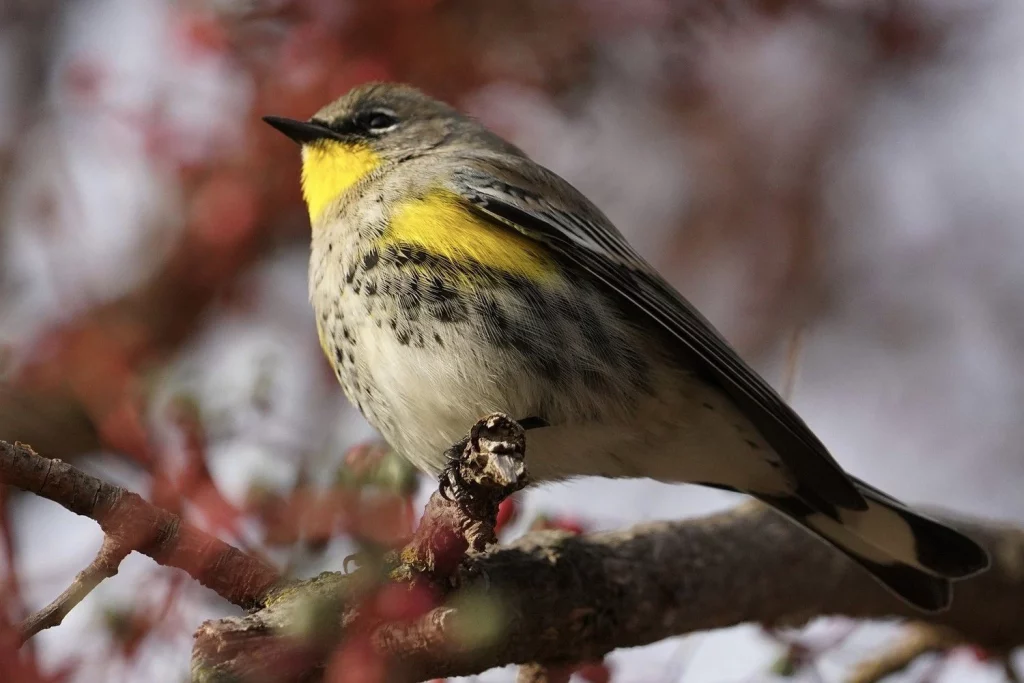
Yellow Warblers are the most commonly observed yellow birds in Montana during the breeding season. They are typically spotted from May to October and appear in around 30% of summer checklists.
These small, bright yellow birds exhibit a yellow-green back, with males featuring chestnut streaks on their breasts. Females and juveniles have less vibrant colors compared to males.
Scientific name: Setophaga petechia
Length: 4.7-5.1 inches (12-13 cm)
Weight: 0.3-0.4 ounces (9-11 g)
Wingspan: 6.3-7.9 inches (16-20 cm)
Yellow Warblers undertake long-distance migrations to breed in Canada and the US, excluding southeastern states, before heading to Central and South America for winter. However, they can be spotted during migration in southeastern US states.
You can find Yellow Warblers along streams, wetlands, thickets, and field edges, where they search for insects such as caterpillars, midges, beetles, bugs, and wasps.
The provided sound recording allows you to appreciate the melodic song of the Yellow Warbler.
Nests of Yellow Warblers are typically found in small trees or shrubs. They are constructed from bark, grass, and plant materials intricately woven together and secured with spider webs, forming a cup-shaped structure. The nest is lined with softer materials like hair, feathers, and plant down.
Yellow Warblers lay up to seven eggs, which take around twelve days to hatch. The young then spend an additional ten days in the nest before leaving.
To attract Yellow Warblers to your backyard, offer suet, oranges, peanut butter, and plants with berries. Additionally, plant native species that attract insects without the use of pesticides and create a habitat with secluded planting near birdbaths with fountains to provide protection.
Fun fact: Yellow Warblers frequently encounter cowbirds, which lay their eggs in their nests. If a cowbird egg is detected, Yellow Warblers build a new nest on top of the old one and start anew, a process they can repeat up to six times!
4. Yellow-rumped Warbler
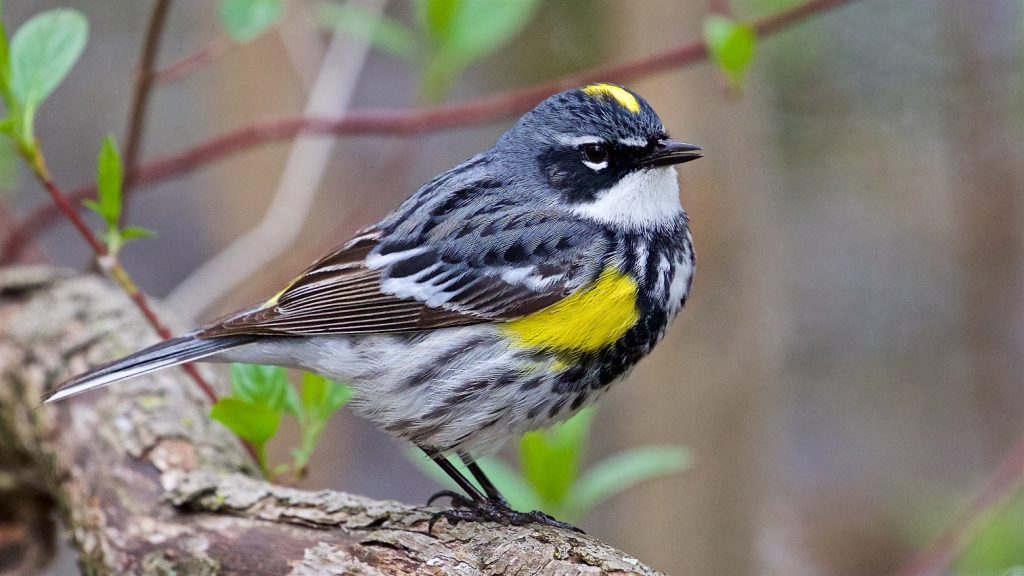
Yellow-rumped Warblers can be observed in western Montana during the breeding season, but their numbers increase during migration in May and September. They appear in 21% of summer checklists and up to 39% of checklists during migration.
These birds display a gray plumage with flashes of
yellow on their face, sides, and rump, and white wings. Females may exhibit a slight brown coloration, while winter birds appear paler brown with bright yellow rumps and sides, transitioning to bright yellow and gray in spring.
Scientific name: Setophaga coronata
Length: 4.7-5.5 inches (12-14 cm)
Weight: 0.4-0.5 ounces (12-13 g)
Wingspan: 7.5-9.1 inches (19-23 cm)
Yellow-rumped Warblers primarily breed in Canada, parts of the Rockies, and the Appalachian Mountains. During migration, they can be observed in the Midwest before overwintering in southern and southwestern US states, the Pacific Coast, Mexico, and Central America.
These warblers can be found in coniferous forests, particularly during the breeding season. In winter, they seek open areas with fruiting shrubs. Their diet consists mainly of insects in summer and shifts to fruit consumption, including bayberry and wax myrtle, during migration and winter.
The provided sound recording allows you to listen to the distinct song of the Yellow-rumped Warbler.
Nests of Yellow-rumped Warblers are constructed by females in conifer trees using twigs, pine needles, and grass, with a lining of soft grass, moss, and hair. They lay up to six eggs, which hatch in approximately two weeks, and the young leave the nest after another two weeks.
To attract Yellow-rumped Warblers to your backyard, provide sunflower seeds, suet, raisins, and peanut butter.
Fun fact: Yellow-rumped Warblers form flocks numbering in the thousands during winter and can display aggression towards other species that encroach upon their territory.
5. Cedar Waxwing

Cedar Waxwings are predominantly observed in Montana during the breeding season, although some individuals remain year-round. They appear in 16% of summer checklists and 2% of winter checklists.
These elegant, sociable birds possess pale brown heads, chests, and crests, transitioning to gray on their backs, wings, and tails. Their bellies exhibit a pale yellow hue, and the tips of their wings feature a vibrant yellow coloration. A narrow black mask adorns their eyes, and their wingtips boast bright red accents.
Scientific name: Bombycilla cedrorum
Length: 5.5-6.7 inches (14-17 cm)
Weight: 1.1 ounce (32 g)
Wingspan: 8.7-11.8 inches (22-30 cm)
Cedar Waxwings breed in Canada before migrating to the southern US, Mexico, and Central America for winter. They are resident year-round in the northern US states.
You can find Cedar Waxwings in berry bushes, woodlands, grasslands, towns, and along streams. Their diet primarily consists of fruit, but they also consume insects during summer.
The provided sound recording allows you to listen to the distinctive call of the Cedar Waxwing.
Nests of Cedar Waxwings are constructed in trees using twigs, grass, hair, and plant materials, with a lining of pine needles and soft grass. The female lays up to six eggs, which hatch after approximately twelve days, and the young leave the nest around sixteen days later.
To attract Cedar Waxwings to your backyard, plant native trees and shrubs that bear small fruit, such as serviceberry, dogwood, juniper, winterberry, and hawthorn. You can also offer fruit on platform feeders.
Fun fact: Cedar Waxwings engage in a unique courtship behavior where they exchange gifts between potential mates.
6. Evening Grosbeak
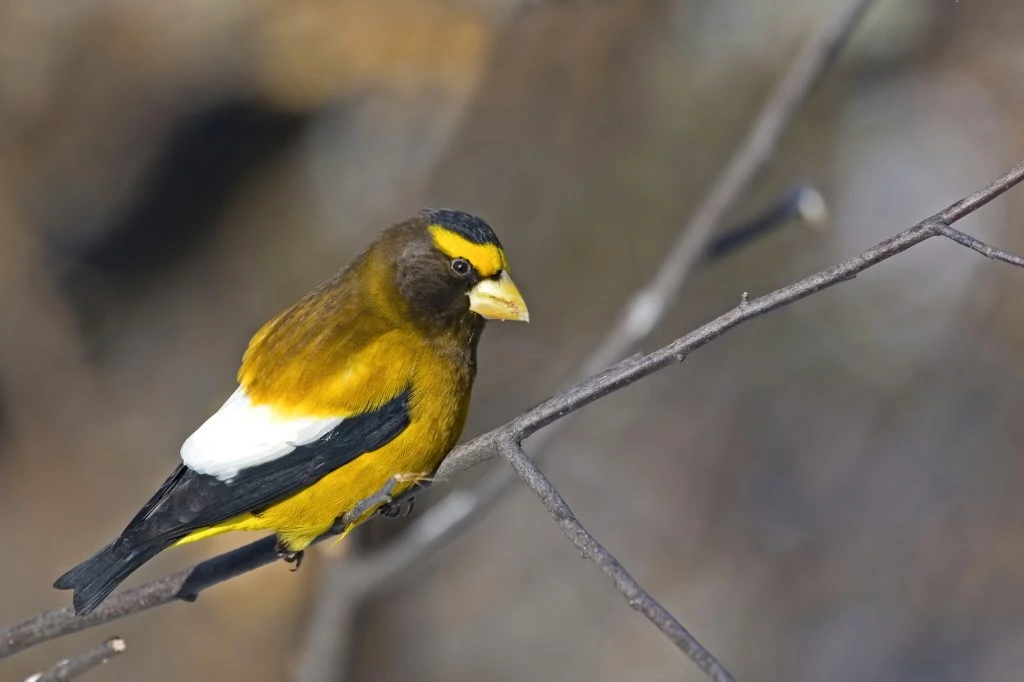
Grosbeaks are vulnerable species in Montana, but they can be observed during the breeding season in the western part of the state, with some individuals remaining in the northwest throughout the year. They appear in 8% of summer checklists.
These birds possess a robust build, prominent bills, and a striking yellow and black plumage. Adult males feature a bright yellow stripe above their eyes, creating a fierce appearance. Their heads are black, with gray necks, while their chests and bellies exhibit a vibrant yellow coloration. A white patch decorates their wings.
Females and juvenile males display greenish bills, predominantly gray bodies, black and white wings, and a hint of yellow on the neck.
Scientific name: Hesperiphona vespertina
Length: 6.3-8.7 inches (16-22 cm)
Weight: 1.37-3.04 ounces (38.7-86.1 g)
Wingspan: 12-14 inches (30-36 cm)
Evening Grosbeaks remain year-round in southern Canada and along the west coast, reaching as far as northern California. However, during poor cone crops, they migrate south to various US states.
You can find Evening Grosbeaks in forests and mountainous regions. During winter, they are often drawn to backyard bird feeders due to the availability of food.
Their diet consists of flower buds in spring, insect larvae from treetops in summer, and seeds, berries, and small fruits in winter.
The provided sound recording allows you to listen to the unique calls of Evening Grosbeaks.
Nests of Evening Grosbeaks are usually located up to 100 feet above the ground in pine trees. The nests are loosely constructed using twigs, rootlets, grass, moss, and pine needles. Females lay up to five eggs, which incubate for two weeks before hatching.
To attract Evening Grosbeaks to your backyard during winter, offer sunflower seeds, berries, and maple buds.
Fun fact: Evening Grosbeaks possess powerful bills capable of cracking open seeds that smaller birds cannot access, leading them to scavenge whatever is left behind.
7. Western Tanager
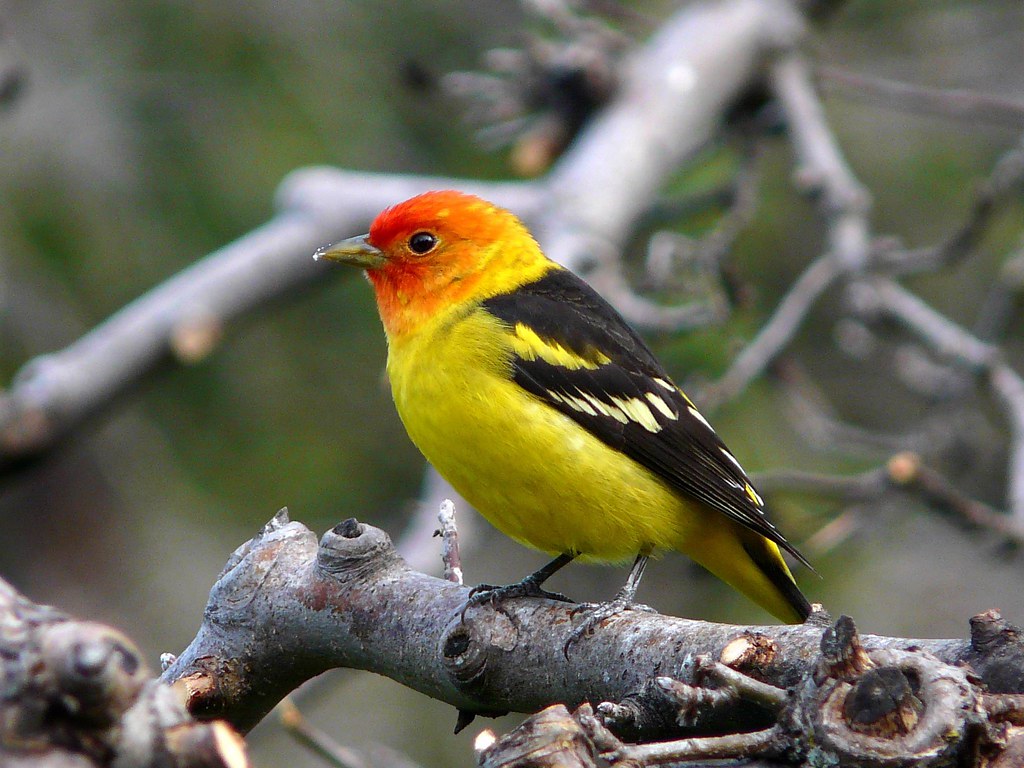
Western Tanagers are observed in Montana during the breeding season, primarily from May to September, with a few individuals staying until January. They appear in 12% of summer checklists.
These birds boast a vibrant orange-red head, yellow body, and black wings. Females possess red faces and yellow-green bodies.
Scientific name: Piranga ludoviciana
Length: 6.3-7.5 inches (16-19 cm)
Weight: 0.8-1.3 ounces (24-36 g)
Wingspan: 5.9-7.5 inches (15-19 cm)
Western Tanagers breed in western US states and western Canada. During migration, they can be observed in the eastern and southern regions of their range. In winter, they reside in Mexico and Central America.
Western Tanagers typically inhabit open conifer forests, often concealed within the canopy despite their bright coloring. Over the past forty years, their population numbers have actually increased.
Their diet primarily consists of insects during summer, including wasps and grasshoppers. In fall and winter, they also consume fruit.
The provided sound recording allows you to listen to the melodious song of the Western Tanager.
Nests of Western Tanagers are constructed by females in open areas of trees. They are made from large twigs, roots, smaller twigs, and woven into a sturdy cup shape. The nest is lined with soft materials such as grass, pine needles, hair, and other plant materials. Females lay around four eggs, which hatch in approximately two weeks.
To attract
Western Tanagers, create a habitat with dried fruit, cut oranges, and other fruits, and plant bird-friendly native species.
Fun fact: The red coloring of Western Tanagers is likely obtained from consuming insects that produce pigments they cannot generate themselves.
8. Yellow-headed Blackbird
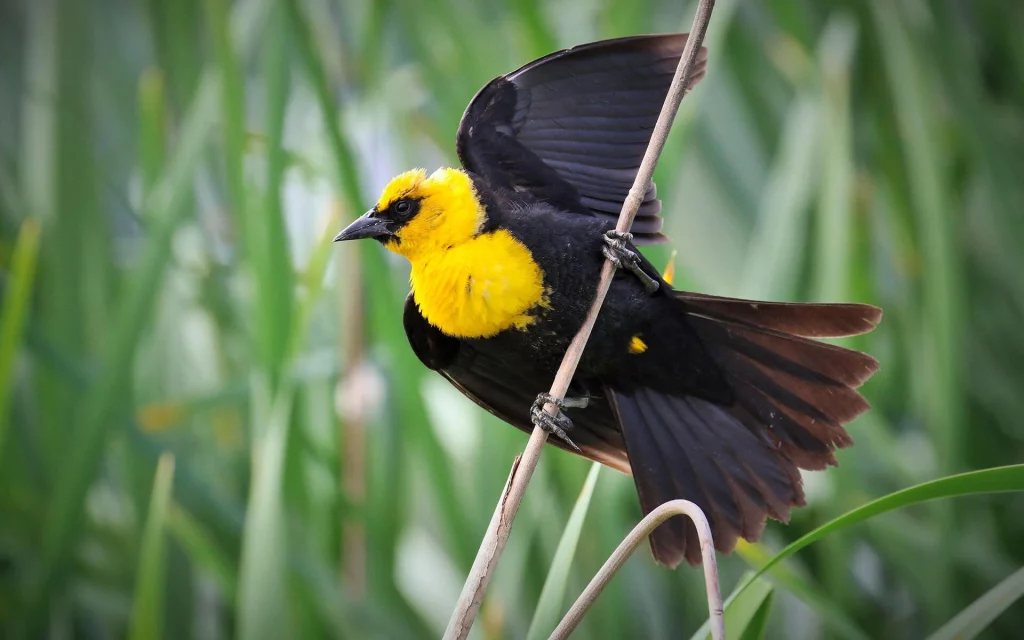
Yellow-headed Blackbirds spend the summer in Montana and are primarily observed from April to October. They appear in 11% of summer checklists.
These striking birds possess glossy black bodies with bright yellow heads and chests, along with white patches on their wings in males. Females exhibit a brown coloration instead of black, and their yellow heads are less vibrant. They are larger than Red-winged Blackbirds.
Scientific name: Xanthocephalus xanthocephalus
Length: 8.3-10.2 inches (21-26 cm)
Weight: 1.6-3.5 ounces (44-100 g)
Wingspan: 16.5-17.3 inches (42-44 cm)
Yellow-headed Blackbirds primarily breed in western and prairie wetlands, nesting among the reeds. They forage in the surrounding wetlands, grasslands, and fields, with a diet focused on insects during the summer.
After breeding, Yellow-headed Blackbirds migrate to fields and farmlands in southwestern US states and Mexico for winter, often forming large flocks.
Their diet shifts to include seeds and grains during winter.
The provided sound recording allows you to listen to the screeching buzz and other musical notes characteristic of Yellow-headed Blackbirds.
Nests of Yellow-headed Blackbirds are constructed using long, wet stems woven together and attached to cattails or reeds above the water. Females lay 2-5 eggs, which take approximately two weeks to hatch, followed by another week or two before the young leave the nest.
To attract Yellow-headed Blackbirds to your yard, provide sunflower seeds.
Fun fact: Yellow-headed Blackbirds flip over stones to flush out insects, using this clever technique for hunting.
9. Common Yellowthroat
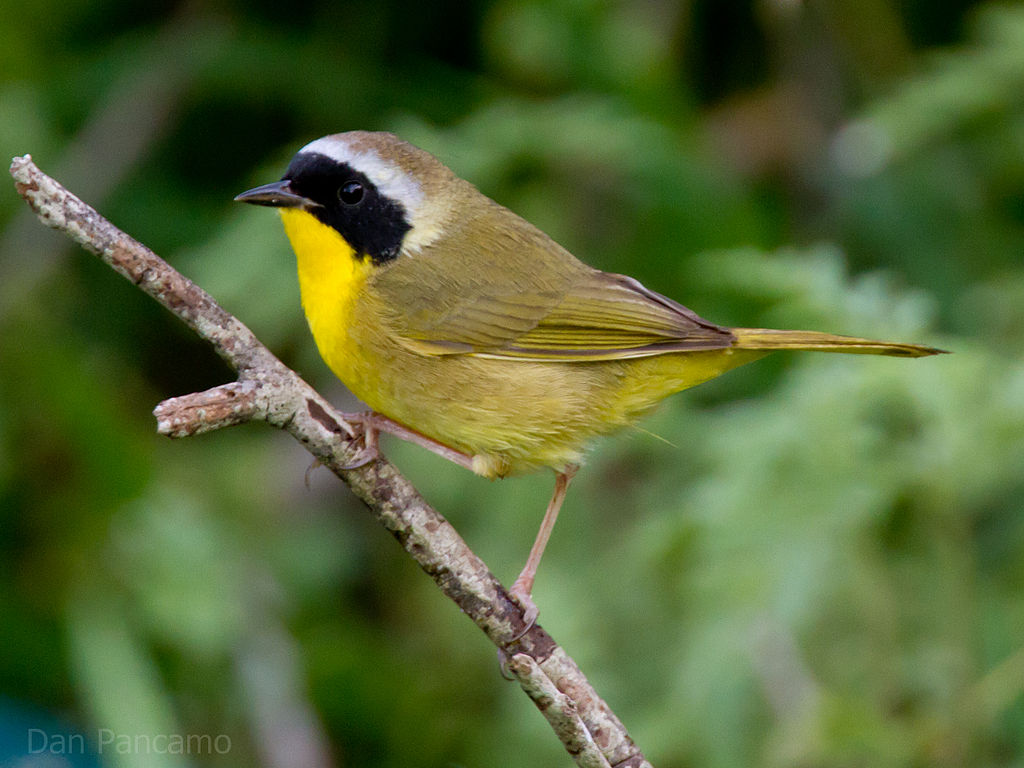
Common Yellowthroats are primarily observed in Montana during the breeding season and appear in 11% of summer checklists. They arrive in May and begin their migration in October.
These small songbirds feature a brownish back and vibrant yellow undersides, with long tails. Males possess black masks across their faces. The intensity of yellow can vary geographically, and their undersides may exhibit more olive tones in certain areas.
Scientific name: Geothlypis trichas
Length: 4.3-5.1 inches (11-13 cm)
Weight: 0.3-0.3 ounces (9-10 g)
Wingspan: 5.9-7.5 inches (15-19 cm)
Common Yellowthroats breed during the summer over most of North America, excluding Alaska and northern Canada. Some individuals remain year-round along the Gulf Coast and Pacific Southwest. They migrate south for winter.
You can often find Common Yellowthroats in marshy or wetland areas and brushy fields, where they reside amidst thick and tangled vegetation.
The provided sound recording allows you to listen to the distinct song of the Common Yellowthroat.
Nests of Common Yellowthroats are constructed by females near the ground in marshy areas, supported by reeds. The nests are made from grass, sedges, and other plant materials intricately woven into a cup shape, secured with leaves and grass. They lay up to six eggs, which hatch in approximately twelve days, with the young leaving the nest after a similar duration.
To attract Common Yellowthroats to larger backyards, create dense vegetation and plant native species that attract insects.
Fun fact: The black mask of Common Yellowthroats serves as a
visual cue to male suitors, triggering attacks when fake birds lacking the mask are used, but no aggression occurs when the bird features no mask.
10. Western Kingbird

Western Kingbirds are observed in Montana during summer, primarily from May to September, appearing in 7% of checklists during this period.
These large flycatchers possess yellow bellies, whitish chests, gray heads, grayish-brown wings, and black tails with white edges.
Scientific name: Tyrannus verticalis
Length: 7.9-9.4 inches (20-24 cm)
Weight: 1.3-1.6 ounces (37-46 g)
Wingspan: 15.0-16.1 inches (38-41 cm)
Western Kingbirds breed during the summer in western US states, the plains region, and into Canada. They migrate to Mexico and Central America, although some individuals may overwinter in southern Florida.
You can find Western Kingbirds in open habitats, often perched on fences and utility lines, patiently waiting to catch insects in mid-flight.
The provided sound recording allows you to listen to the unique call of the Western Kingbird.
Nests of Western Kingbirds are usually constructed in trees or shrubs, but they may also utilize human-made buildings or posts. The female builds the nest using twigs, grass, and plant materials, woven into a cup shape. They lay up to seven eggs, with an incubation period of two to three weeks, followed by a similar duration for the young to leave the nest.
To attract Western Kingbirds to your yard, create an insect-friendly environment and plant elderberry or hawthorn trees, which they also feed on.
Fun fact: Western Kingbird parents continue to feed their young for an additional three weeks after leaving the nest.
11. Orange-crowned Warbler
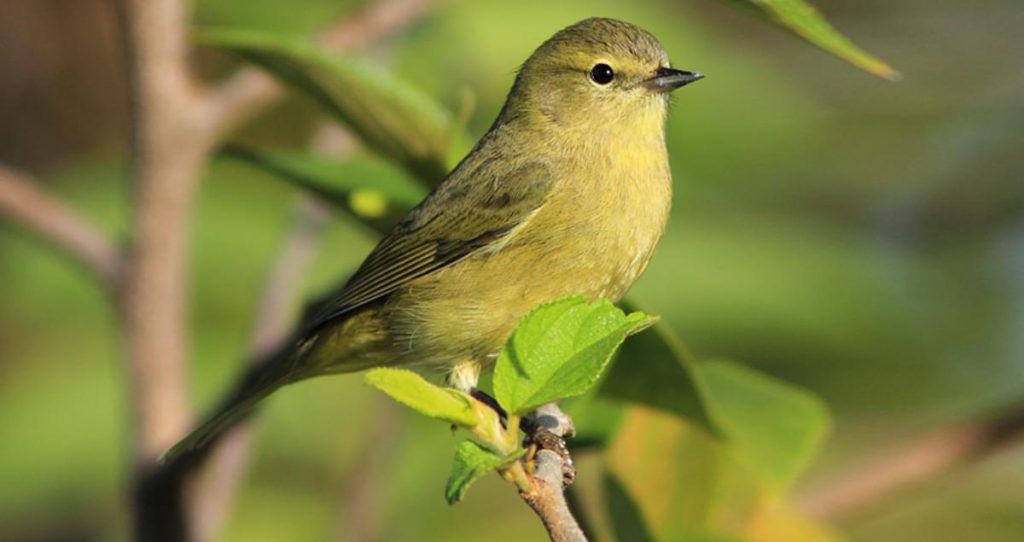
Orange-crowned Warblers can be spotted in Montana during the breeding season, primarily from May to September. They are recorded in 5% of summer checklists.
These warblers possess a predominantly olive-green coloration, with a hint of yellow on the underparts. Their orange crown, which is often hidden, serves as a distinguishing feature.
Scientific name: Leiothlypis celata
Length: 4.7-5.5 inches (12-14 cm)
Weight: 0.3-0.4 ounces (9-11 g)
Wingspan: 7.1-8.3 inches (18-21 cm)
Orange-crowned Warblers undertake long-distance migrations, breeding in northern regions of North America and migrating to southern US states, Mexico, and Central America for winter.
You can find Orange-crowned Warblers in a variety of habitats, including shrubby areas, woodlands, and thickets. They forage for insects and spiders, often in the lower parts of vegetation.
The provided sound recording allows you to listen to the song of the Orange-crowned Warbler.
Nests of Orange-crowned Warblers are built by females in low shrubs, typically near the ground. The nest is constructed from twigs, leaves, grass, and bark, lined with finer materials such as hair and plant fibers. They lay up to six eggs, which hatch after approximately two weeks.
Attract Orange-crowned Warblers to your backyard by providing a mix of shrubby and wooded areas, with plenty of insect-attracting vegetation.
Fun fact: Orange-crowned Warblers have a relatively plain appearance, with their orange crown often concealed, earning them the nickname “the little brown job.”
12. Wilson’s Warbler
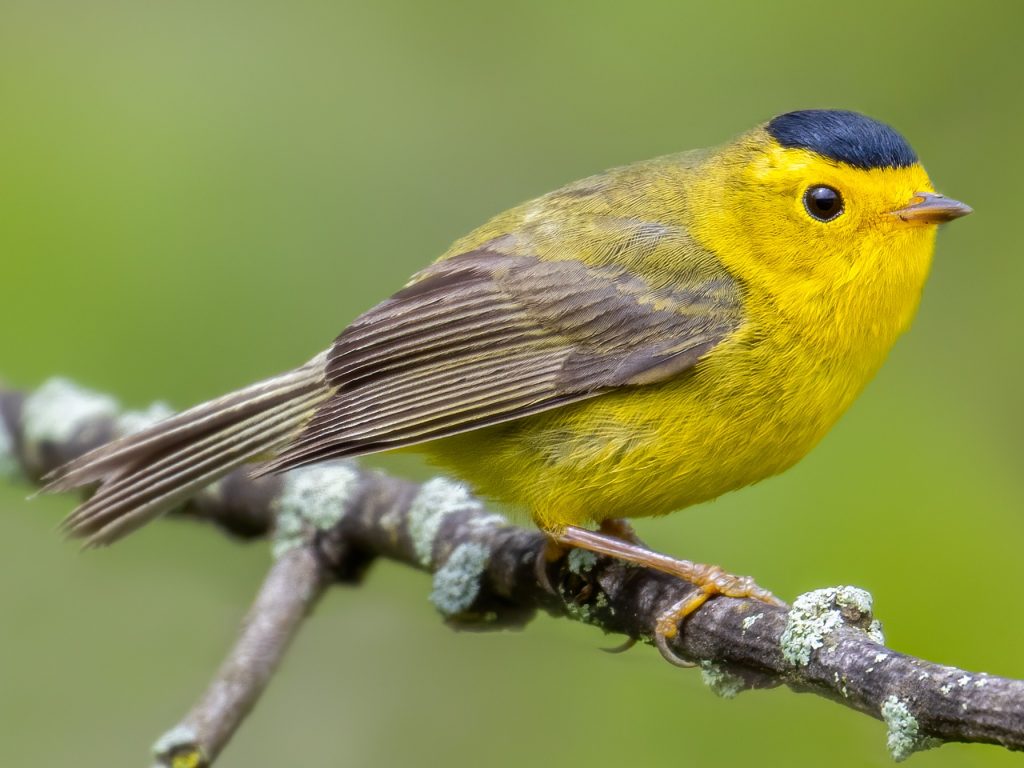
Wilson’s Warblers are commonly observed in Montana during the breeding season, primarily from May to September. They appear in 4% of summer checklists.
These small songbirds showcase a vibrant yellow coloration on their undersides and olive-green on their backs. Males possess a distinct black cap, while females exhibit a lighter cap.
Scientific name: Cardellina pusilla
Length: 4.7-5.1 inches (12-13 cm)
Weight: 0.3-0.4 ounces (9-11 g)
Wingspan: 6.3-7.9 inches (16-20 cm)
Wilson’s Warblers undertake extensive migrations, breeding in western North America and migrating to Mexico, Central America, and even parts of South America for winter.
You can find Wilson’s Warblers in various habitats, including forests, thickets, and shrubby areas near water. They actively forage for insects and spiders among vegetation.
The provided sound recording allows you to listen to the cheerful song of the Wilson’s Warbler.
Nests of Wilson’s Warblers are built by females in low shrubs and bushes, usually near the ground. The nest is constructed from grass, plant fibers, and moss, forming a cup-shaped structure. They lay up to six eggs, which incubate for around two weeks.
To attract Wilson’s Warblers to your backyard, provide dense vegetation and diverse plantings that support insect populations.
Fun fact: Wilson’s Warblers are known for their impressive migratory feats, flying across vast distances each year.
13. American Redstart
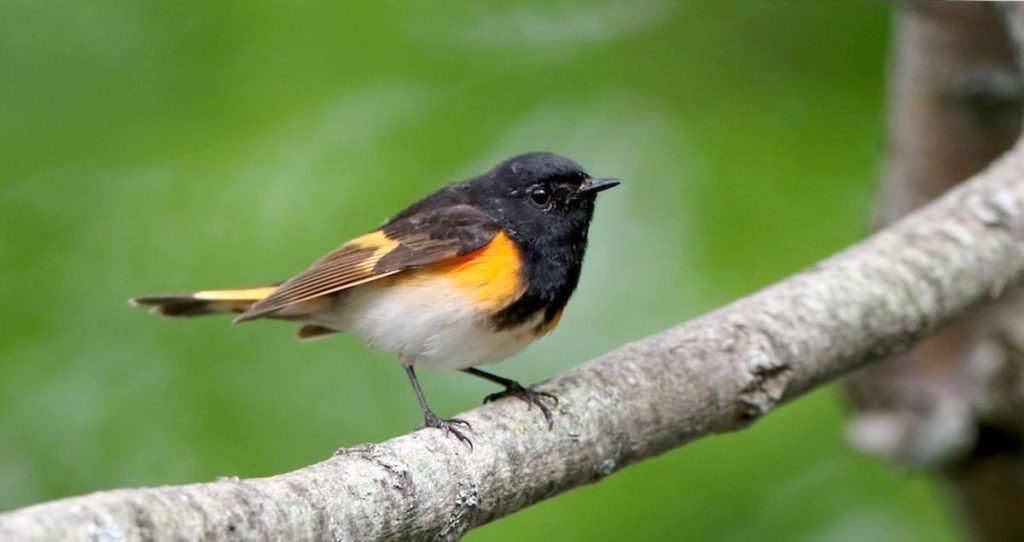
American Redstarts can be spotted in Montana during the breeding season, primarily from May to September. They are recorded in 3% of summer checklists.
These warblers exhibit striking black and orange plumage. Males feature black upperparts with bright orange patches on their wings, tail, and sides. Females and immature birds possess grayish-green upperparts and yellow patches.
Scientific name:
Setophaga ruticilla
Length: 4.3-5.1 inches (11-13 cm)
Weight: 0.3-0.4 ounces (9-11 g)
Wingspan: 7.5-8.7 inches (19-22 cm)
American Redstarts undertake long-distance migrations, breeding in North America and migrating to Central and South America for winter.
You can find American Redstarts in various habitats, including forests, woodlands, and shrubby areas near water. They are known for their active foraging behavior, frequently flicking their wings and tails to flush out insects.
The provided sound recording allows you to listen to the vibrant song of the American Redstart.
Nests of American Redstarts are built by females in shrubs and saplings, usually near the ground. The nest is constructed from grass, bark, and plant fibers, often incorporating spider silk for added strength. They lay up to five eggs, which hatch after approximately two weeks.
To attract American Redstarts to your backyard, provide a mix of trees, shrubs, and water sources.
Fun fact: American Redstarts are known for their unique foraging strategy called “flush-pursuit,” where they rapidly open and close their wings to flush out insects from foliage.
14. Nashville Warbler
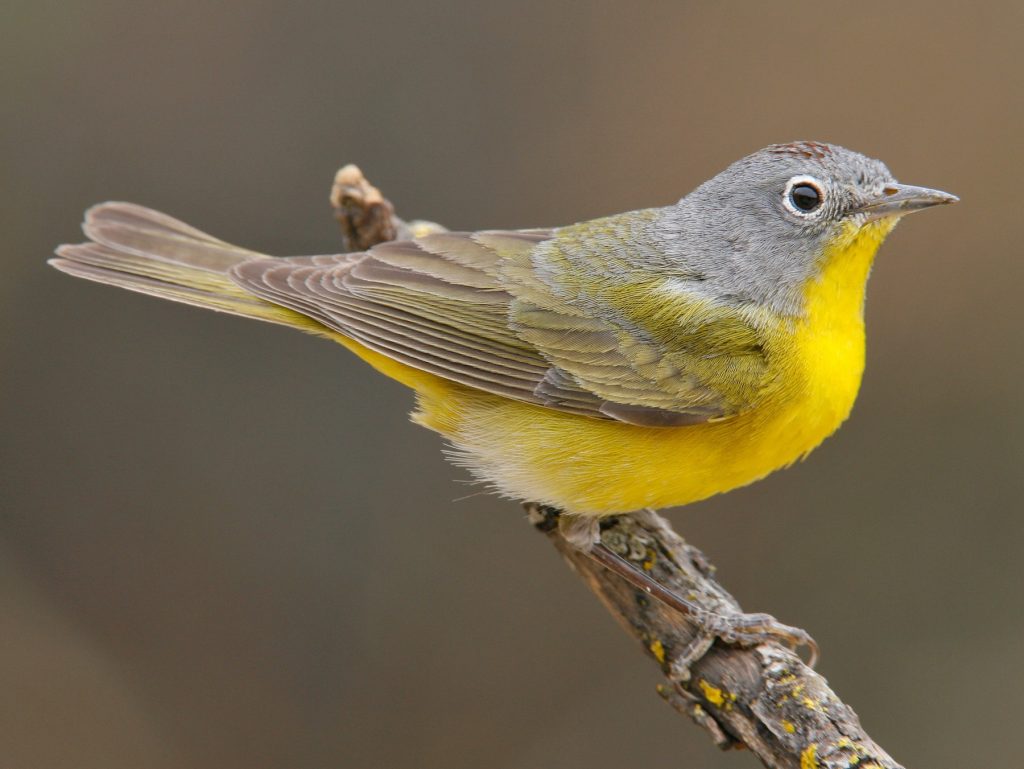
Nashville Warblers can be observed in Montana during the breeding season, primarily from May to September. They appear in 2% of summer checklists.
These small warblers showcase a predominantly yellow coloration, with grayish-olive on their backs. They have a distinctive white eye-ring and a gray cap.
Scientific name: Leiothlypis ruficapilla
Length: 4.3-4.7 inches (11-12 cm)
Weight: 0.2-0.3 ounces (6-9 g)
Wingspan: 6.3-7.5 inches (16-19 cm)
Nashville Warblers undertake extensive migrations, breeding in northern North America and migrating to Central America and the Caribbean for winter.
You can find Nashville Warblers in various habitats, including forests, woodlands, and shrubby areas. They actively forage for insects among vegetation, often gleaning from leaves and branches.
The provided sound recording allows you to listen to the melodic song of the Nashville Warbler.
Nests of Nashville Warblers are built by females in shrubs and low trees, usually near the ground. The nest is constructed from grass, plant fibers, and moss, forming a cup-shaped structure. They lay up to six eggs, which hatch after approximately two weeks.
To attract Nashville Warblers to your backyard, provide a mix of shrubby and wooded areas with ample insect-attracting vegetation.
Fun fact: Nashville Warblers were named after the city of Nashville, Tennessee, where the species was first discovered and described.
15. Baltimore Oriole
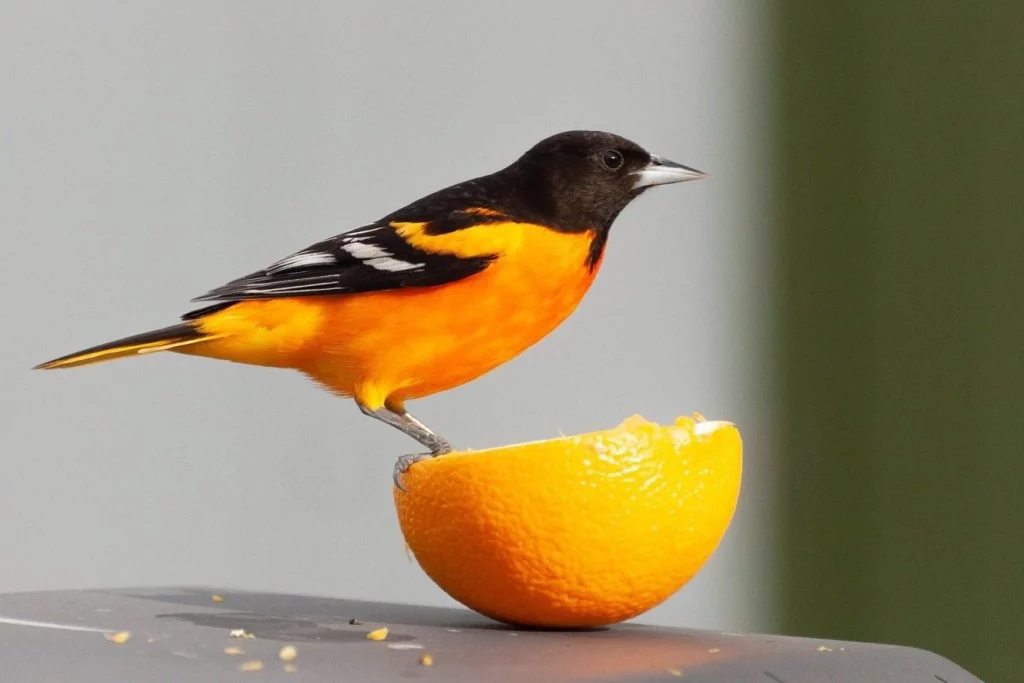
Baltimore Orioles can be spotted in Montana during the breeding season, primarily from May to September. They are recorded in 2% of summer checklists.
These medium-sized songbirds exhibit vibrant orange plumage on their undersides, with contrasting black on their wings and head in males. Females feature a similar color pattern but with a duller appearance.
Scientific name: Icterus galbula
Length: 6.7-7.5 inches (17-19 cm)
Weight: 1.0-1.4 ounces (28-40 g)
Wingspan: 9.8-11.8 inches (25-30 cm)
Baltimore Orioles undertake extensive migrations, breeding in North America and migrating to Central America for winter.
You can find Baltimore Orioles in various habitats, including woodlands, forest edges, and suburban areas. They actively
forage for insects, nectar, and fruits, often visiting feeders with sweet offerings.
The provided sound recording allows you to listen to the rich and flute-like song of the Baltimore Oriole.
Nests of Baltimore Orioles are intricately woven by females, hanging from the branches of trees. The nest is constructed from grass, plant fibers, and string, forming a pendulous pouch. They lay up to six eggs, which hatch after approximately two weeks.
To attract Baltimore Orioles to your backyard, provide feeders with nectar, oranges, and other sweet offerings, along with native trees and shrubs.
Fun fact: Baltimore Orioles are known for their elaborate and skillful nest-weaving abilities, creating intricately designed nests using various materials.
16. Orchard Oriole
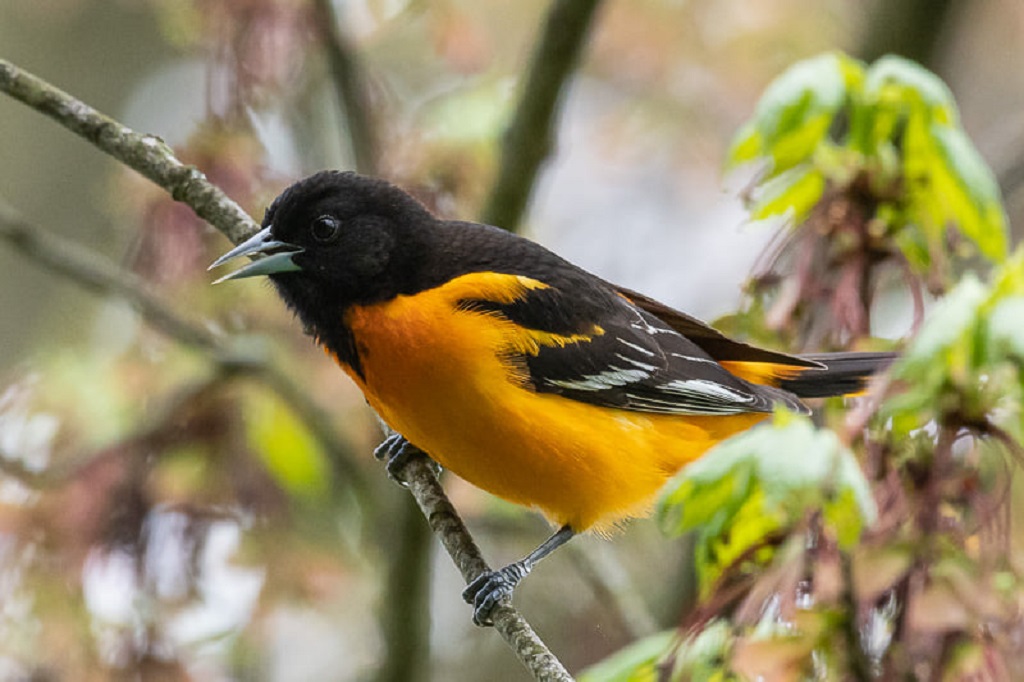
Orchard Orioles can be observed in Montana during the breeding season, primarily from May to September. They appear in 2% of summer checklists.
These small songbirds exhibit a distinct color pattern, with males featuring a brick-red coloration on their undersides, head, and shoulders, and black wings. Females possess a greenish-yellow coloration.
Scientific name: Icterus spurius
Length: 5.5-6.3 inches (14-16 cm)
Weight: 0.4-0.6 ounces (11-17 g)
Wingspan: 8.3-9.1 inches (21-23 cm)
Orchard Orioles undertake extensive migrations, breeding in North America and migrating to Central and South America for winter.
You can find Orchard Orioles in various habitats, including orchards, woodlands, and forest edges. They actively forage for insects and feed on nectar and fruits.
The provided sound recording allows you to listen to the melodic song of the Orchard Oriole.
Nests of Orchard Orioles are intricately woven by females, usually hanging from the tips of branches. The nest is constructed from plant fibers, grass, and hair, forming a pendulous pouch-like structure. They lay up to five eggs, which hatch after approximately two weeks.
To attract Orchard Orioles to your backyard, provide fruit feeders, nectar feeders, and a mix of flowering trees and shrubs.
Fun fact: Orchard Orioles are the smallest oriole species found in North America.
17. Dickcissel

Dickcissels can be spotted in Montana during the breeding season, primarily from May to September. They are recorded in 1% of summer checklists.
These medium-sized songbirds exhibit a striking color pattern, with males featuring yellow underparts, grayish-brown upperparts, and a black bib on their chest. Females exhibit a duller coloration.
Scientific name: Spiza americana
Length: 5.9-6.7 inches (15-17 cm)
Weight: 1.0-1.1 ounces (28-32 g)
Wingspan: 10.2-10.6 inches (26-27 cm)
Dickcissels undertake extensive migrations, breeding in North America and migrating to Central and South America for winter.
You can find Dickcissels in grasslands, prairies, and open areas with tall vegetation. They actively forage for seeds and insects, often perching on elevated spots to sing their distinctive song.
The provided sound recording allows you to listen to the unique song of the Dickcissel.
Nests of Dickcissels are built on the ground, usually concealed within vegetation. The nest is constructed from grass, plant fibers, and fine materials, forming a cup-shaped structure. They lay up to six eggs, which hatch after approximately two weeks.
To attract Dickcissels to your backyard, provide open areas with tall grasses and native wildflower plant
ings.
Fun fact: The name “Dickcissel” is derived from the distinctive song of the male, which sounds like “dick-dick-ciss-ciss-cissel.”
18. Lesser Goldfinch
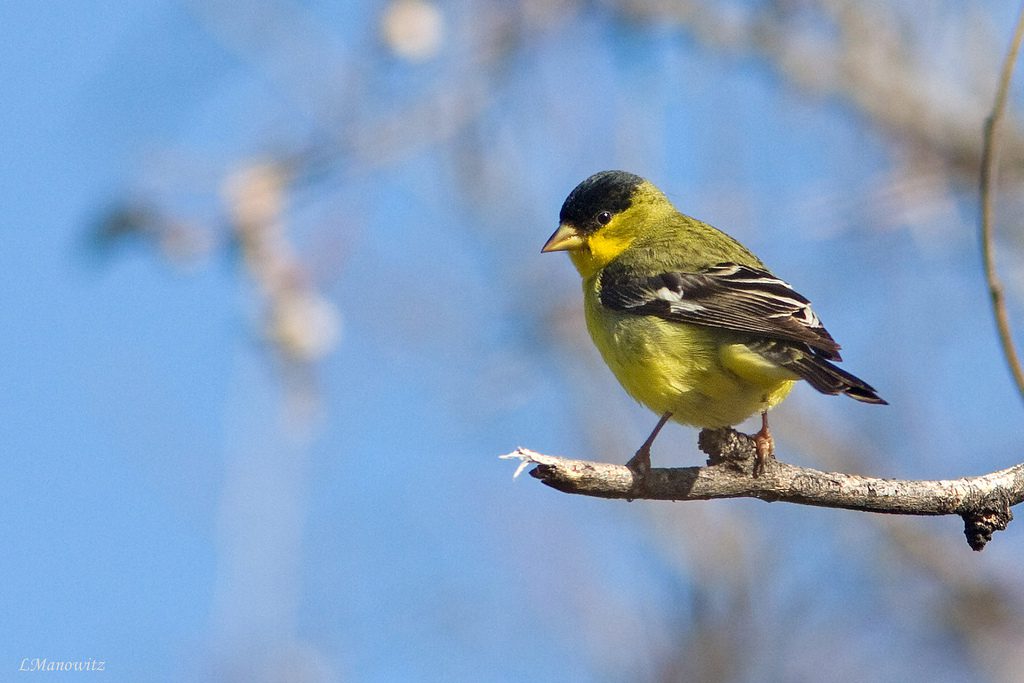
Lesser Goldfinches can be observed in Montana during the winter season. They are recorded in 1% of winter checklists.
These small songbirds exhibit a distinct color pattern, with males featuring a black back and cap, bright yellow underparts, and white patches on their wings. Females possess a duller coloration with grayish-olive upperparts and yellow underparts.
Scientific name: Spinus psaltria
Length: 4.3-4.7 inches (11-12 cm)
Weight: 0.3-0.4 ounces (9-11 g)
Wingspan: 7.5-8.3 inches (19-21 cm)
Lesser Goldfinches breed in western North America and can be found year-round in some southern US states. During winter, they can be observed in Montana.
You can find Lesser Goldfinches in a variety of habitats, including open woodlands, scrublands, and gardens. They primarily feed on seeds, including thistle and sunflower seeds.
The provided sound recording allows you to listen to the cheerful song of the Lesser Goldfinch.
Nests of Lesser Goldfinches are built by females in shrubs and trees, usually in dense vegetation. The nest is constructed from plant fibers, grass, and bark strips, forming a cup-shaped structure. They lay up to six eggs, which hatch after approximately two weeks.
To attract Lesser Goldfinches to your backyard, provide nyjer seed feeders and plant native seed-producing plants.
Fun fact: Lesser Goldfinches often gather in large flocks, creating a lively and colorful spectacle during feeding and socializing.
19. Magnolia Warbler
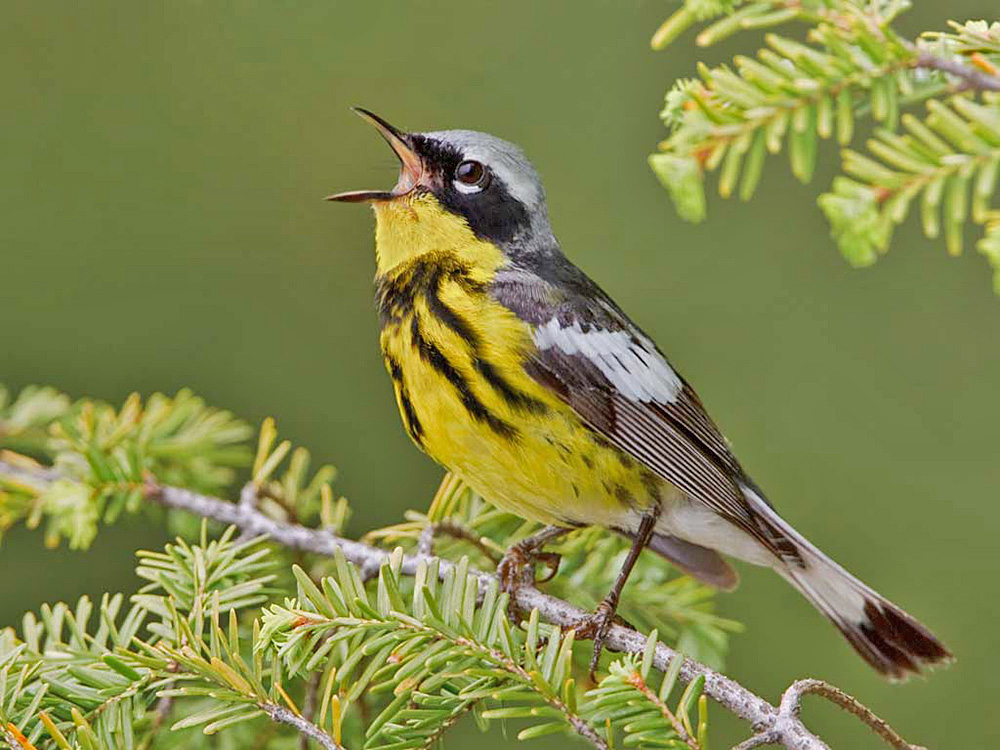
Magnolia Warblers can be observed in Montana during migration, typically passing through during spring and fall. They are recorded in 1% of checklists during migration.
These small warblers showcase a distinctive color pattern, with males featuring bright yellow underparts, gray upperparts, and black streaks on their back and chest. Females possess a duller appearance with similar color patterns.
Scientific name: Setophaga magnolia
Length: 4.3-5.1 inches (11-13 cm)
Weight: 0.3-0.4 ounces (9-11 g)
Wingspan: 7.5-8.3 inches (19-21 cm)
Magnolia Warblers breed in northern North America and migrate to Central and South America for winter.
During migration, you can find Magnolia Warblers in various habitats, including woodlands, shrubby areas, and gardens. They actively forage for insects among foliage and tree canopies.
The provided sound recording allows you to listen to the melodic song of the Magnolia Warbler.
Nests of Magnolia Warblers are built in coniferous trees by females, usually near the trunk. The nest is constructed from plant fibers, moss, and bark strips, forming a cup-shaped structure. They lay up to five eggs, which hatch after approximately two weeks.
Since Magnolia Warblers are primarily observed during migration in Montana, attracting them to your backyard may not be feasible. However, providing a diverse range of native trees and shrubs can create favorable stopover habitats during their migratory journeys.
Fun fact: Despite its name, the Magnolia Warbler does not have a strong association with magnolia trees and is more commonly found in coniferous forests.
20. Palm Warbler
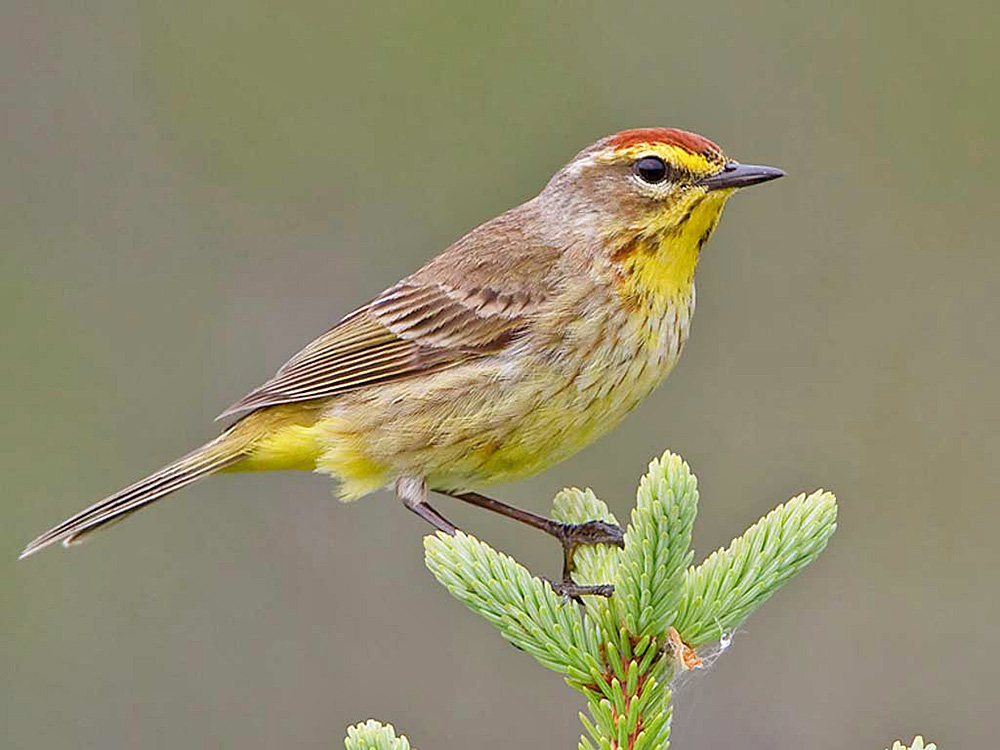
Palm Warblers can be observed in Montana during migration, typically passing through during spring and fall
. They are recorded in 1% of checklists during migration.
These small warblers exhibit a distinctive color pattern, with bright yellow underparts, grayish-brown upperparts, and a rusty cap. They also have a characteristic tail-wagging behavior.
Scientific name: Setophaga palmarum
Length: 4.7-5.1 inches (12-13 cm)
Weight: 0.3-0.4 ounces (9-11 g)
Wingspan: 7.5-8.3 inches (19-21 cm)
Palm Warblers breed in the boreal forests of Canada and migrate to the southeastern United States and the Caribbean for winter.
During migration, you can find Palm Warblers in various habitats, including open woodlands, fields, and marshy areas. They actively forage for insects on the ground, often bobbing their tails.
The provided sound recording allows you to listen to the song of the Palm Warbler.
Nests of Palm Warblers are built on the ground in mossy areas by females. The nest is constructed from grass, bark, and plant fibers, forming a cup-shaped structure. They lay up to five eggs, which hatch after approximately two weeks.
Since Palm Warblers are primarily observed during migration in Montana, attracting them to your backyard may not be feasible. However, providing open spaces with shrubs and bushes can create favorable stopover habitats during their migratory journeys.
Fun fact: Palm Warblers get their name from their fondness for palm trees during winter in their non-breeding range. However, they can also be found in a variety of habitats beyond palm groves.
21. Cape May Warbler
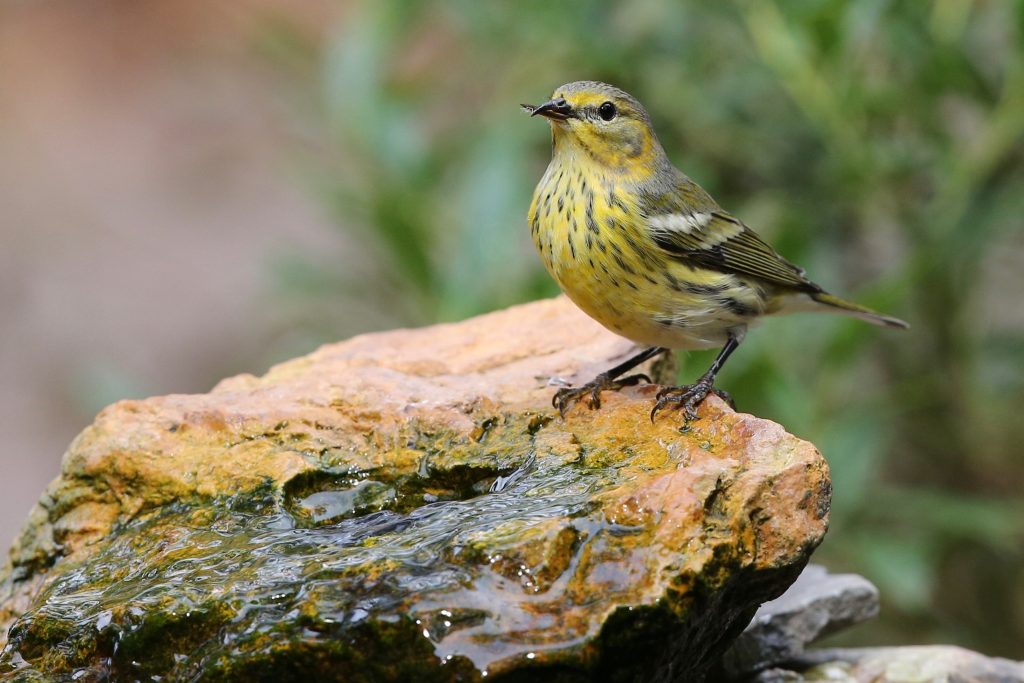
Cape May Warblers can be observed in Montana during migration, typically passing through during spring and fall. They are recorded in 1% of checklists during migration.
These small warblers exhibit a striking color pattern, with males featuring a mix of bright yellow, chestnut, and green on their bodies, along with distinctive streaks on their sides. Females possess a duller appearance with a more olive coloration.
Scientific name: Setophaga tigrina
Length: 4.7-5.1 inches (12-13 cm)
Weight: 0.3-0.4 ounces (9-11 g)
Wingspan: 7.5-8.3 inches (19-21 cm)
Cape May Warblers breed in the boreal forests of Canada and migrate to the Caribbean and northern South America for winter.
During migration, you can find Cape May Warblers in various habitats, including forests, woodlands, and shrubby areas. They actively forage for insects among the foliage, often probing flowers for nectar.
The provided sound recording allows you to listen to the unique song of the Cape May Warbler.
Nests of Cape May Warblers are built in coniferous trees by females, typically near the end of a branch. The nest is constructed from twigs, plant fibers, and lichens, forming a cup-shaped structure. They lay up to five eggs, which hatch after approximately two weeks.
Since Cape May Warblers are primarily observed during migration in Montana, attracting them to your backyard may not be feasible. However, providing a mix of native trees and shrubs can create favorable stopover habitats during their migratory journeys.
Fun fact: Despite its name, the Cape May Warbler does not breed in Cape May, New Jersey, but was named after a specimen collected there.
22. Canada Warbler
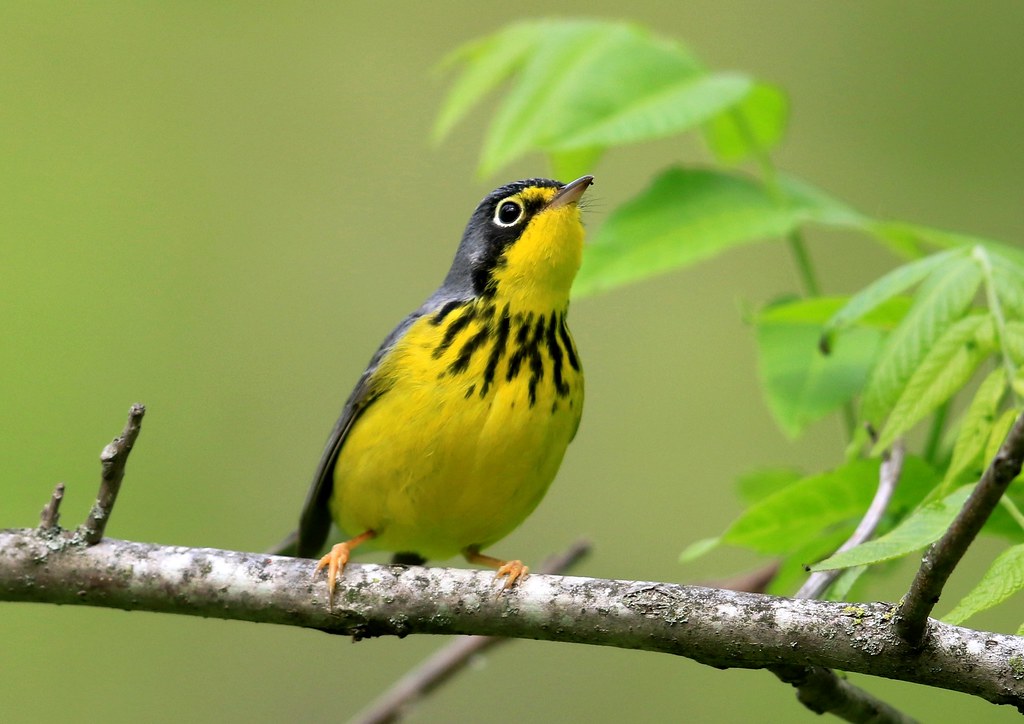
Canada Warblers can be observed in Montana during migration, typically passing through during spring and fall. They are recorded in 1% of checklists during migration.
These small warblers exhibit a distinct color pattern, with bright yellow underparts, grayish upperparts, and a black necklace-like pattern on their neck and upper chest.
Scientific name: Cardellina canadensis
Length: 4.3-5.1 inches (11-13 cm)
Weight: 0.3-0.4 ounces (9-11 g)
Wingspan: 7.5-8.3 inches (19-21 cm)
Canada Warblers breed in the boreal forests of Canada and the northeastern United States and migrate to northern South America for winter.
During migration, you can find Canada Warblers in various habitats, including forests, woodlands, and shrubby areas near water. They actively forage for insects, often hopping along the ground and lower branches.
The provided sound recording allows you to listen to the melodic song of the Canada Warbler.
Nests of Canada Warblers are built on the ground in mossy areas by females. The nest is constructed from grass, leaves, and plant fibers, forming a cup-shaped structure. They lay up to five eggs, which hatch after approximately two weeks.
Since Canada Warblers are primarily observed during migration in Montana, attracting them to your backyard may not be feasible. However, providing a mix of forested and shrubby areas with adequate food sources can create favorable stopover habitats during their migratory journeys.
Fun fact: Canada Warblers are known for their unique habit of flipping over leaves to search for insects, a behavior known as “leaf-flipping.”
23. Scarlet Tanager

Scarlet Tanagers can be observed in Montana during migration, typically passing through during spring and fall. They are recorded in 1% of
checklists during migration.
These medium-sized songbirds exhibit a vibrant color pattern, with males featuring bright red plumage and black wings. Females possess a more subdued appearance with olive-green upperparts and yellowish underparts.
Scientific name: Piranga olivacea
Length: 6.3-7.1 inches (16-18 cm)
Weight: 1.0-1.1 ounces (28-32 g)
Wingspan: 9.8-10.6 inches (25-27 cm)
Scarlet Tanagers breed in the eastern United States and Canada and migrate to northern South America for winter.
During migration, you can find Scarlet Tanagers in various habitats, including forests, woodlands, and edges of clearings. They actively forage for insects among the foliage, often high in the tree canopy.
The provided sound recording allows you to listen to the melodious song of the Scarlet Tanager.
Nests of Scarlet Tanagers are built by females in the upper branches of trees. The nest is constructed from twigs, grass, and bark, forming a cup-shaped structure. They lay up to four eggs, which hatch after approximately two weeks.
Since Scarlet Tanagers are primarily observed during migration in Montana, attracting them to your backyard may not be feasible. However, providing a mix of forested areas and offering bird-friendly habitat can create favorable stopover habitats during their migratory journeys.
Fun fact: Scarlet Tanagers undergo a complete molt after breeding, transitioning from their bright red breeding plumage to a more greenish-yellow plumage resembling the females.
